In for a much needed review is the ViewSonic VX2405-P-MHD. This is one of the latest 24 inch gaming monitors from ViewSonic with a price of 11,599 Pesos.
Specification wise, you’d get an IPS panel with 1 ms of GtG response time and a refresh rate of 144 Hz. It also comes with a stereo speaker, support for adaptive sync and an updated styling.
Disclosure: ViewSonic sent the VX2405-P-MHD for the purpose of this review. The company did not ask me to say anything particular about it.
- Product Page: ViewSonic VX2405-P-MHD Gaming Monitor
- Price: ₱ 11,599 PHP (Lazada)
- Release Date: Q2 2022, Now Available
Technical Specifications
| Display | |
|---|---|
| Panel Size | 23.8 in |
| Aspect Ratio | 16:9 |
| Resolution | 1920 x 1080 |
| Refresh Rate | 144 Hz |
| Adaptive Sync | AMD FreeSync |
| Pixel Density | 92.56 PPI |
| Brightness | 250 cd/㎡ (typical) |
| Contrast Ratio | 1000:1 (typical) |
| Panel Type | IPS |
| Response Time | 1 ms (GtG) |
| Color Space | NTSC 85%, sRGB 120% |
| Color Depth | 8-bit (6 bit + FRC) |
| Backlight | W-LED |
| Surface Treatment | Anti-Glare, Hard Coating (3H) |
| Connectivity | |
| Display Options | 1x DisplayPort 1.4, 2x HDMI 2.0 |
| USB | — |
| Audio | 1x 3.5 mm (out), 2x 2 W stereo speakers |
| Ergonomics | |
| VESA Mount | 100 x 100 mm |
| Pivot | — |
| Swivel | — |
| Tilt | -5°/+20° |
| Lift | — |
| Anti-strain | Blue Light Filter |
| Dimensions | |
| Length | 540 mm |
| Width | 48 mm |
| Height | 323 mm |
| Weight | 3.1 kg |
Packaging and Accessories
The ViewSonic VX2405-P-MHD comes in a slim eco-friendly packaging.
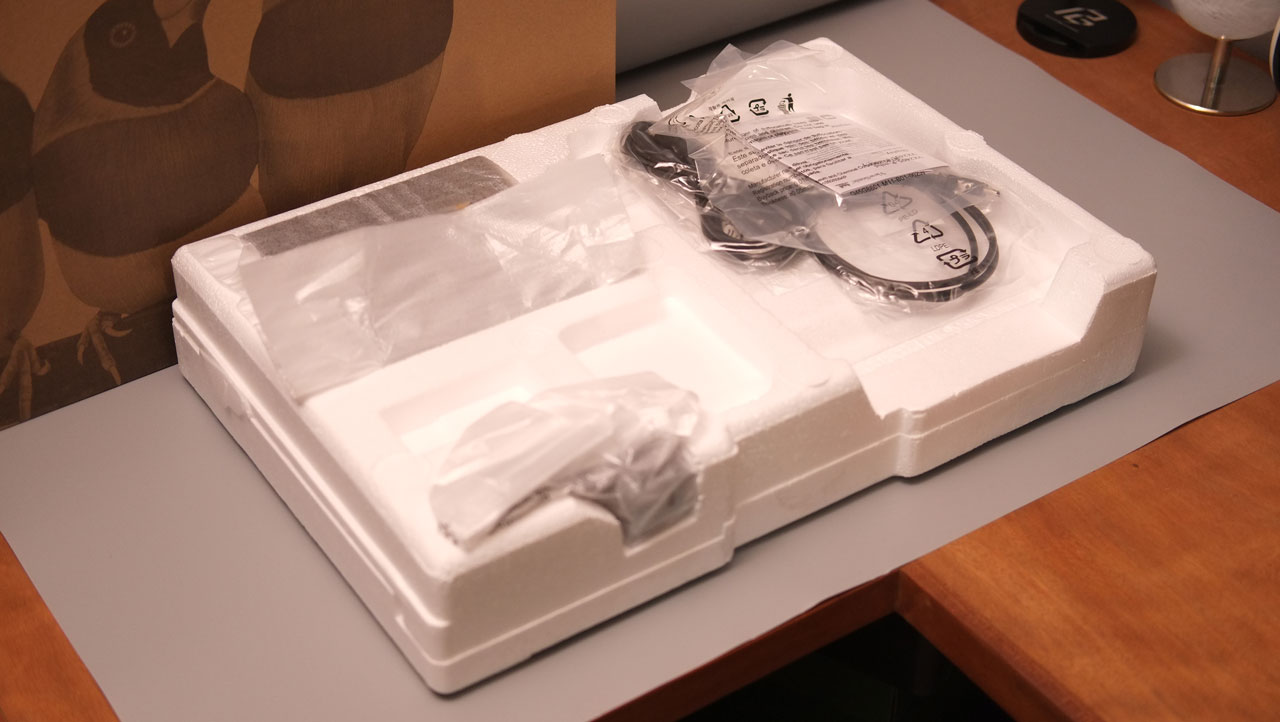
The packaging should contain the following items inside:
- VX2405-P-MHD
- Stand and attachment
- 3-pin Plug (IEC C13)
- HDMI Cable (v1.4)
- Quick Start Guide
Decent bundle of accessories we got here.
Design, Build and Connectivity
The VX2405-P-MHD sports a redesigned base and frame – actually the first one I’ve seen so far with this look from the company’s recent catalogue. The new base sports this textured and glossy design which is something I am not a fan of.
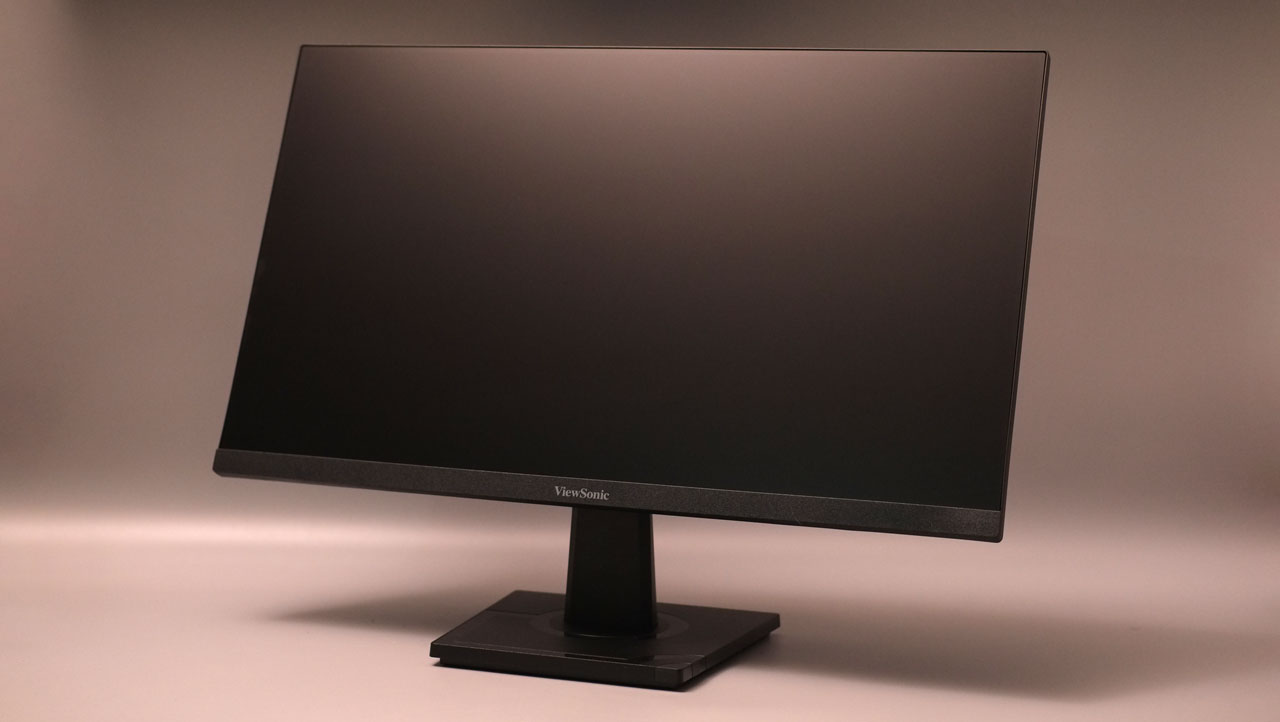
The back follows the general design ethos of the display which is a nice departure to the busy and edgy looking gaming monitors of yesteryears. Here, you could see the VESA mount, Kensington lock and the buttons for the OSD.
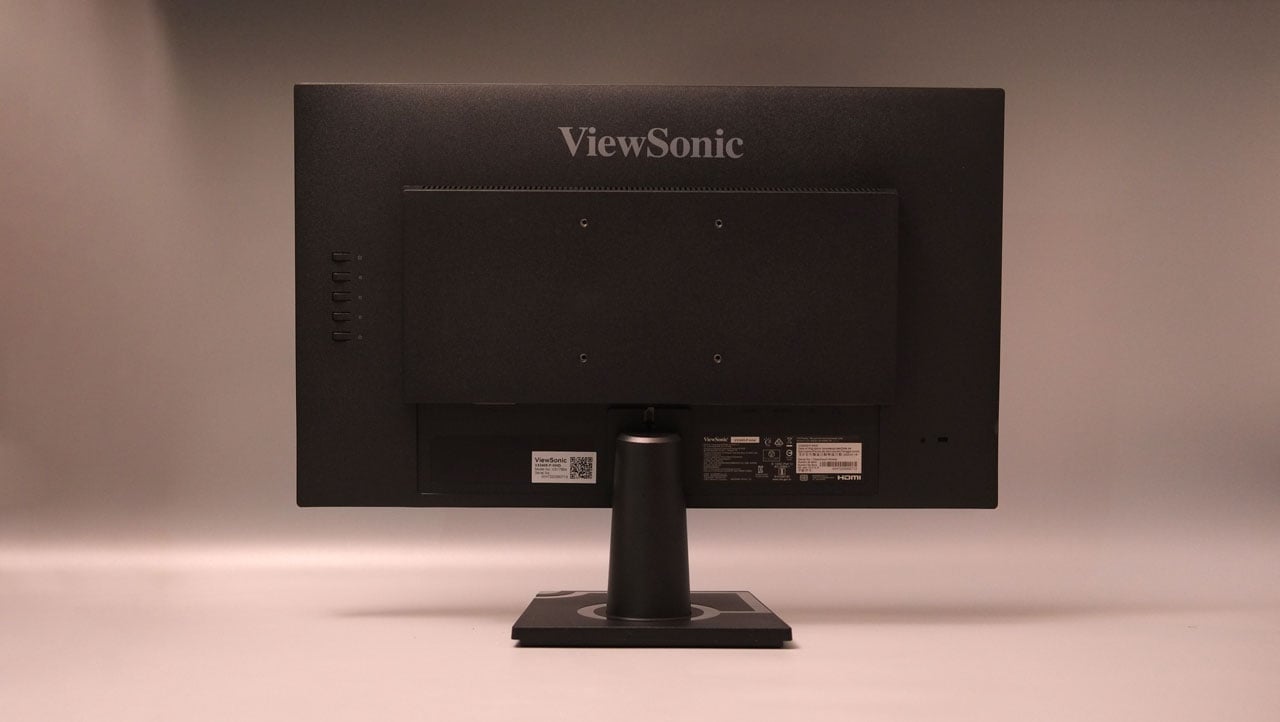
Connectivity options are tucked away at the bottom but with hard to see legends so its better to make your own. This one comes with an internal power supply though for those who are looking for a neater look. Ventilation looks proper too which is a plus.
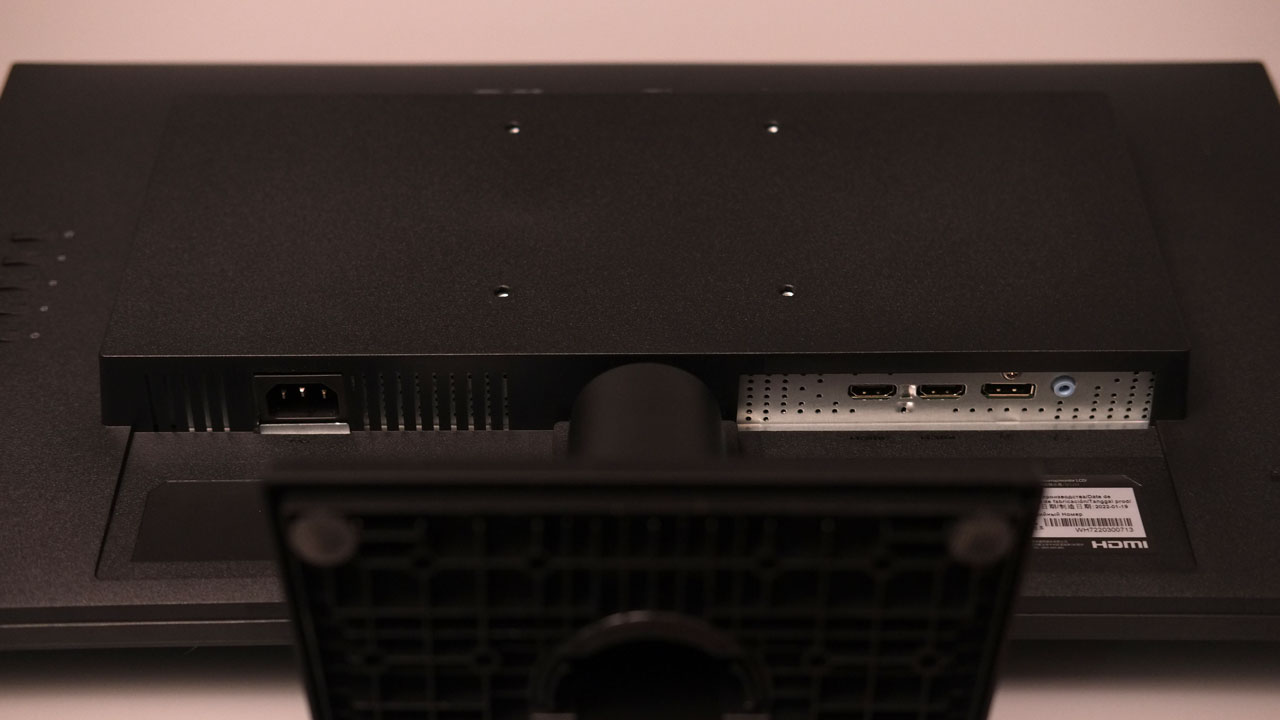
Nothing much to scrutinize here except for the already stated.
OSD and Navigation
Now the OSD itself comes with tons of sub menus but there are only few that we want to check out here. First out is the View Mode. This is where you could select the built-in profiles of the VX2405.
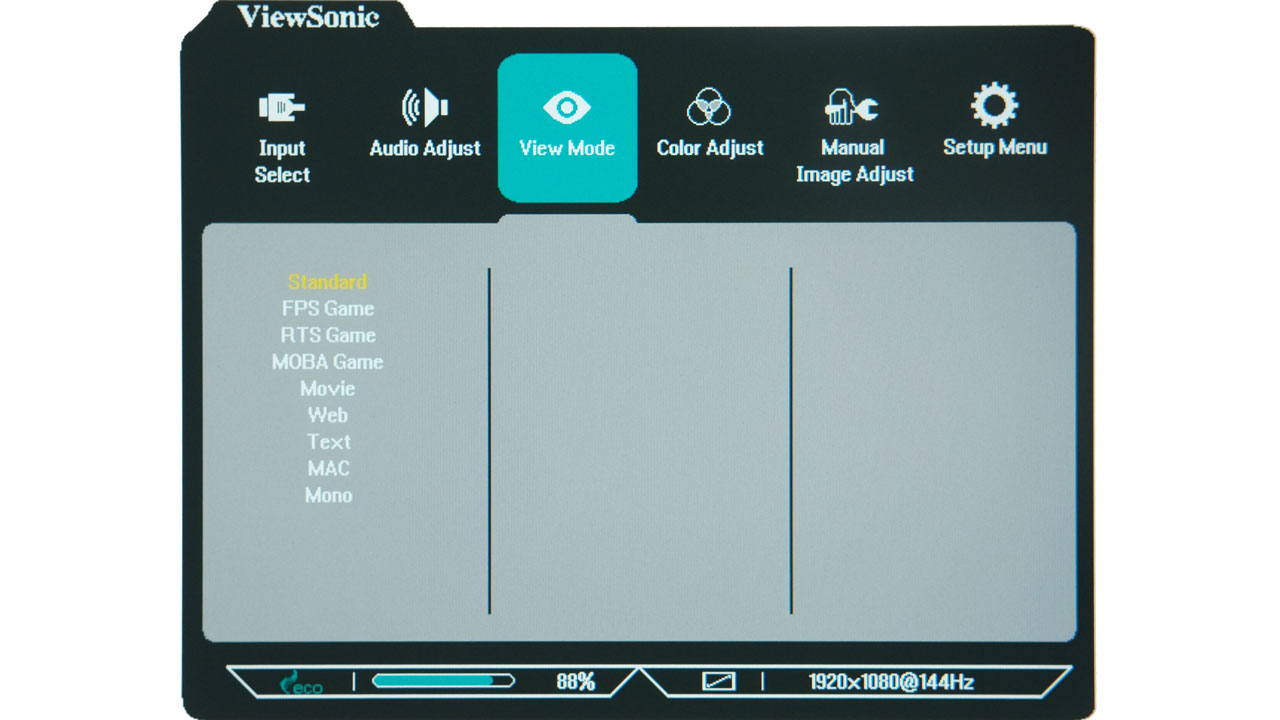
Color Adjust is where the brightness, contrast, color temperature, color space and color range are located. Some of these settings will be disabled depending on the profiles selected.
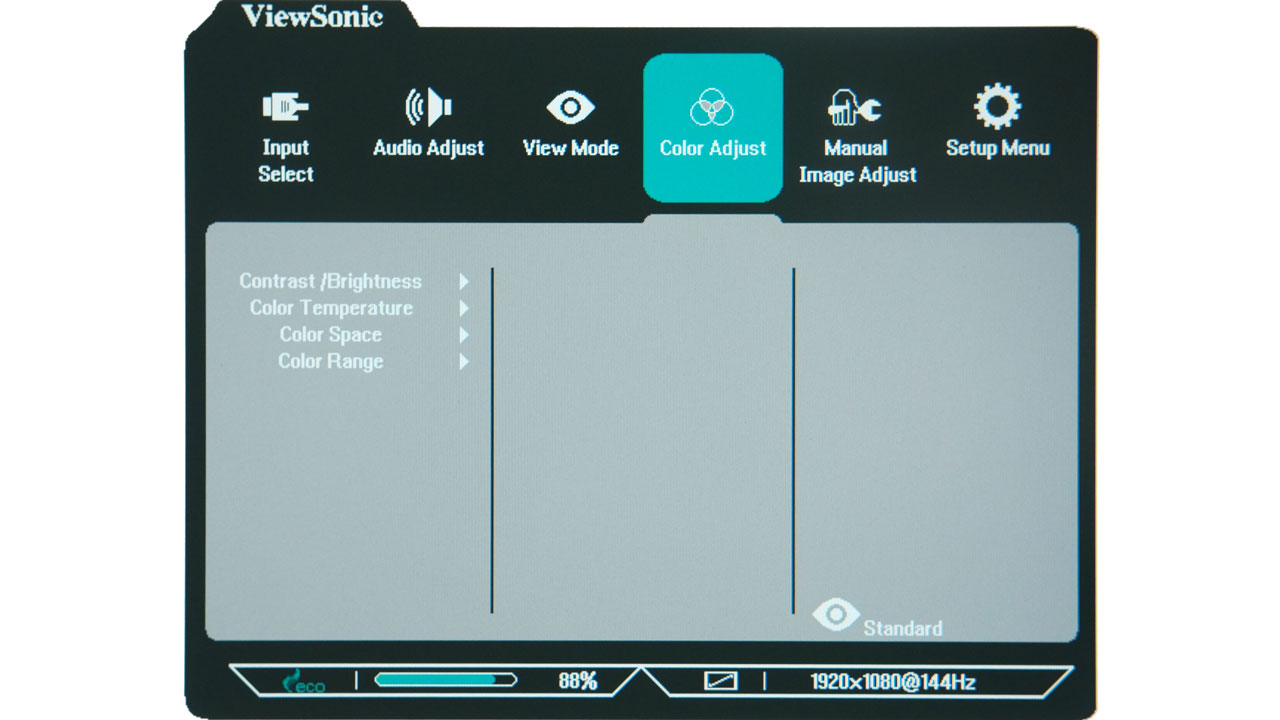
Manual Image Adjust is where the bulk of advanced settings are located. That includes Black Stabilization which is a major contributor to the gamma levels. This defaults to 50% which is gamma 2.2 according to my measurements. Response Time is also located here with 3 options to choose from.
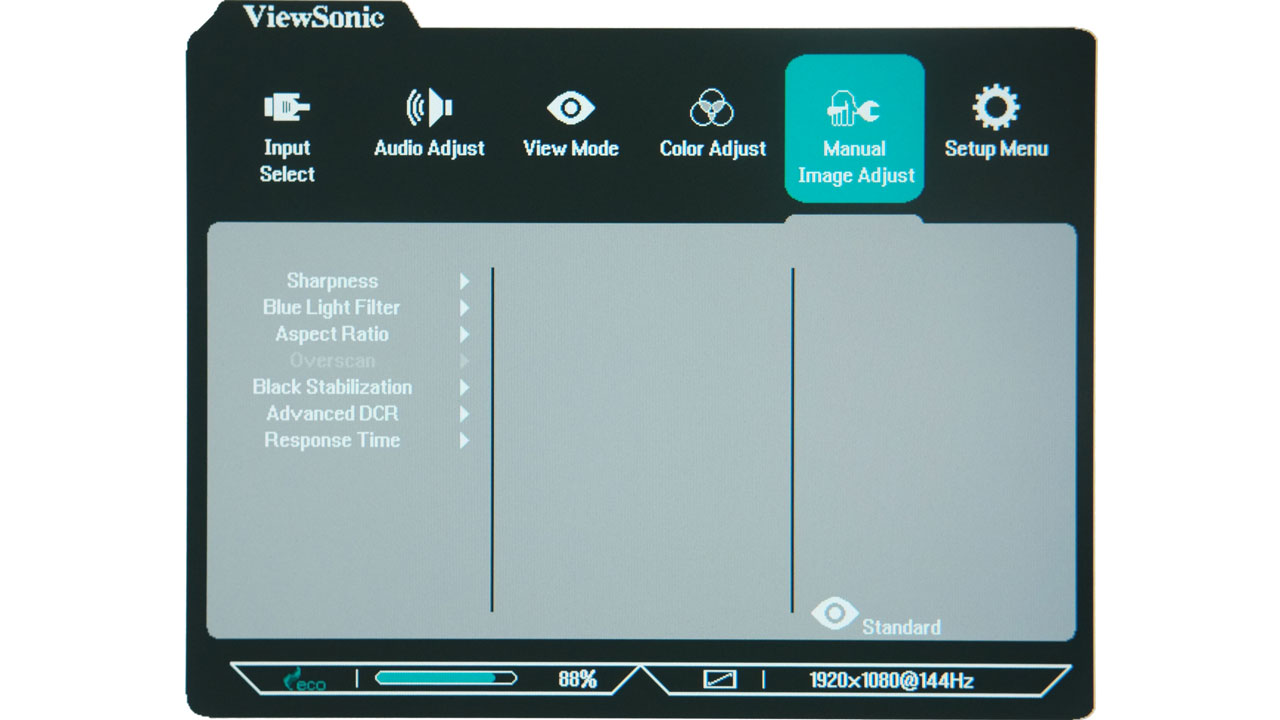
Finally we get to see the Setup Menu. This is yet another advanced menu but with more gaming oriented options. That includes Adaptive-Sync and 1 ms mode.
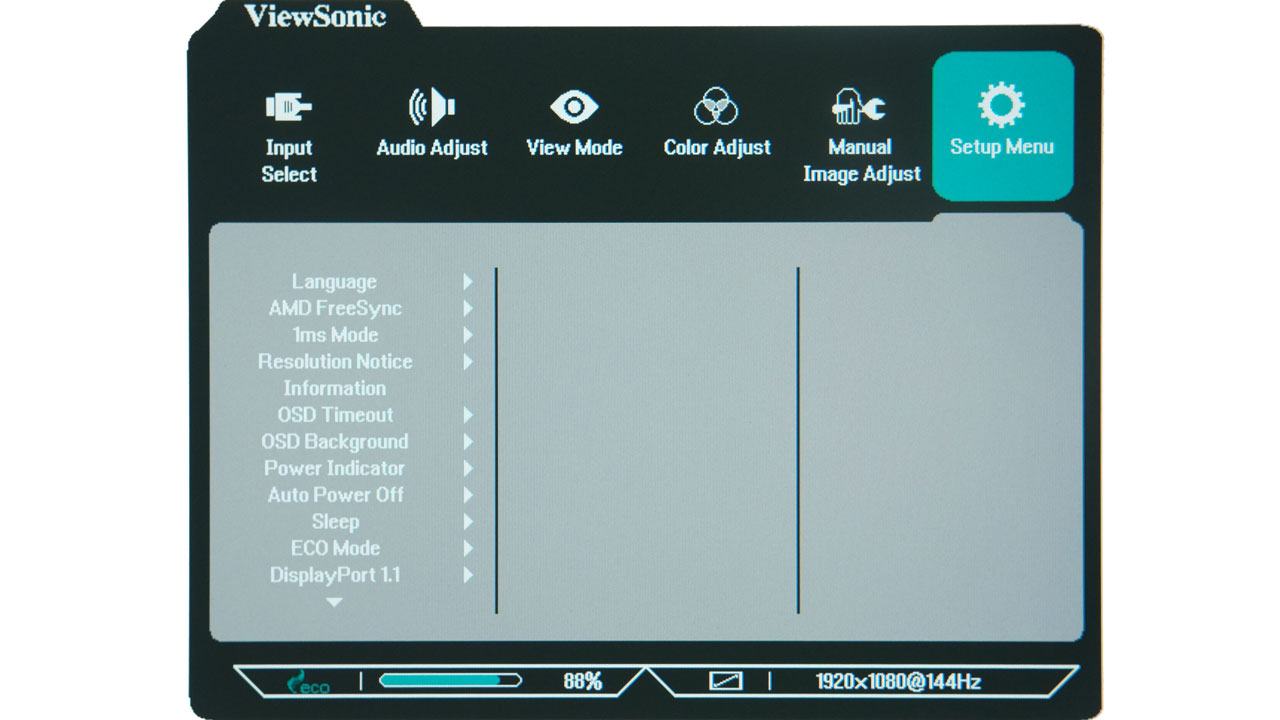
OSD and navigation are for the most part is decent. A joystick and a more organized selection of menus would be better though compared to the button based interface. Who am I to complain at this price point though.
Ergonomics
The ViewSonic VX2405-P-MHD is a 24-inch 1080P display, which puts it at a relatively good PPI level of 92.56. My desk for an instance is about 30″ deep and I never had a hard time using this monitor even halfway its depth.
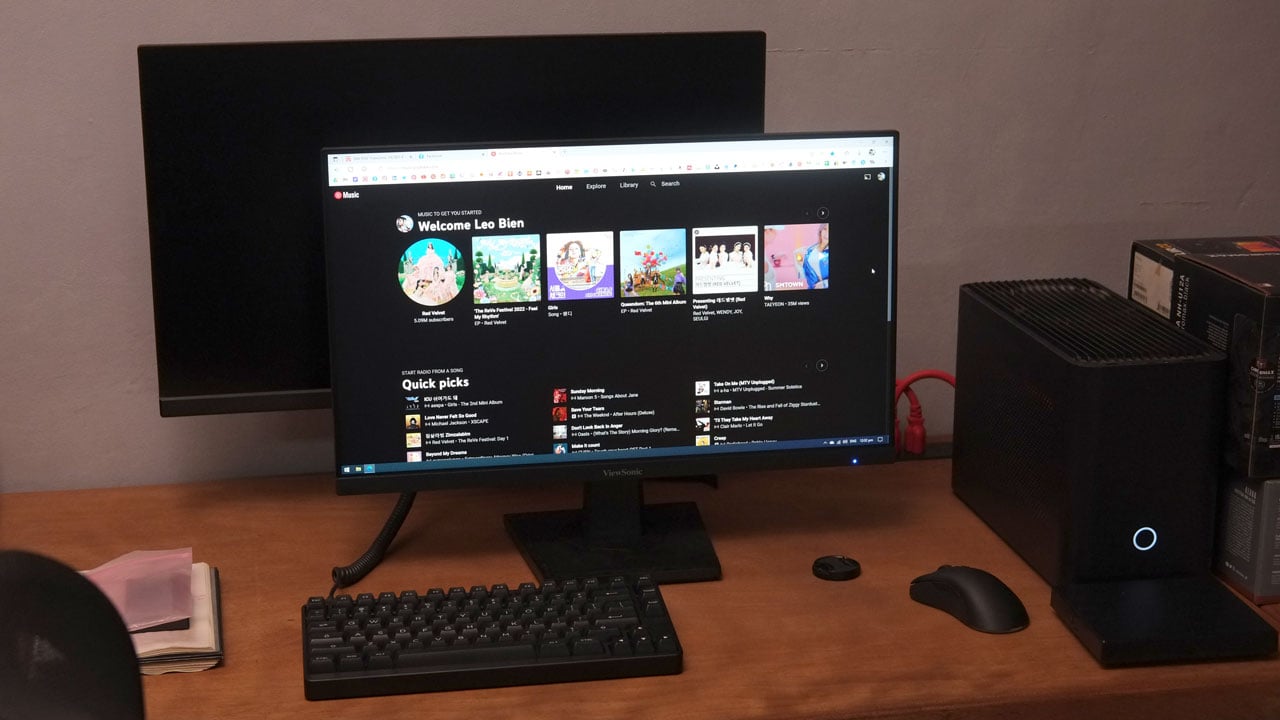
Actual ergonomics are decent at best. We only get -5°/+20° of tilt which is a courtesy of its easy to assemble stand. Aside from these basic ergonomic features, the monitor also comes with a text mode and a blue light filter.
Test Setup and Methodology
Our test setup relies on the measurements taken from the Data Color Spyder5ELITE display calibration system and the Time Sleuth latency testing device. It is important to note that we are testing the review sample after burn-in, with at least 24-hours of uptime. This is done so to negate the FOTB (fresh out the box) state of the DUT (device under test), yielding better benchmarking consistency.
| Test Setup | |
|---|---|
| Display Chain | PC > Nvidia RTX 2060 > Monitor |
| Measurement Tools | DataColor Spyder5 Elite, Time Sleuth |
| Resolution and Color Depth | Native (excluding Time Sleuth) |
| Software | DataColor Spyder5 Elite 5.5, AIDA64 Extreme, Google Chrome (TestUFO) |
Measurements obtained from a display panel will vary with operating temperature and ambient room light to name a few. In our case, we test monitors at an ambient room light level of 150cd/m2 with a display brightness level of 120cd/m2.
Preset Analysis:
Brightness, contrast and white point are measured in their respected values. The test aims to check the presets nearest to our target for calibration.
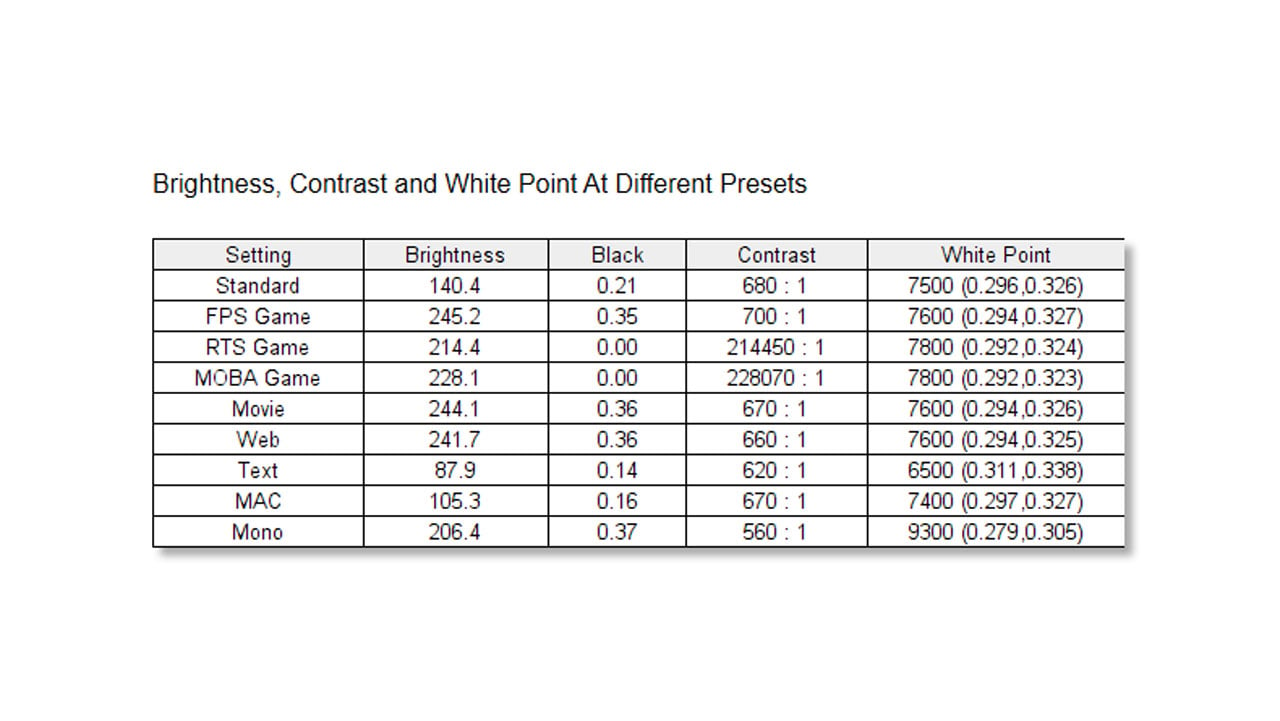
The Text preset is the closes to our target (6500K) but it wont go up to 120 cd/m2 so we went with the Standard profile for calibration instead. That said, the VX2405-P-MHD comes with the same limitations of the previously reviewed 32-inch ViewSonic gaming monitor.
Color Gamut
Color gamut is measured in percentage (%). The test aims to check the color space coverage of the display.
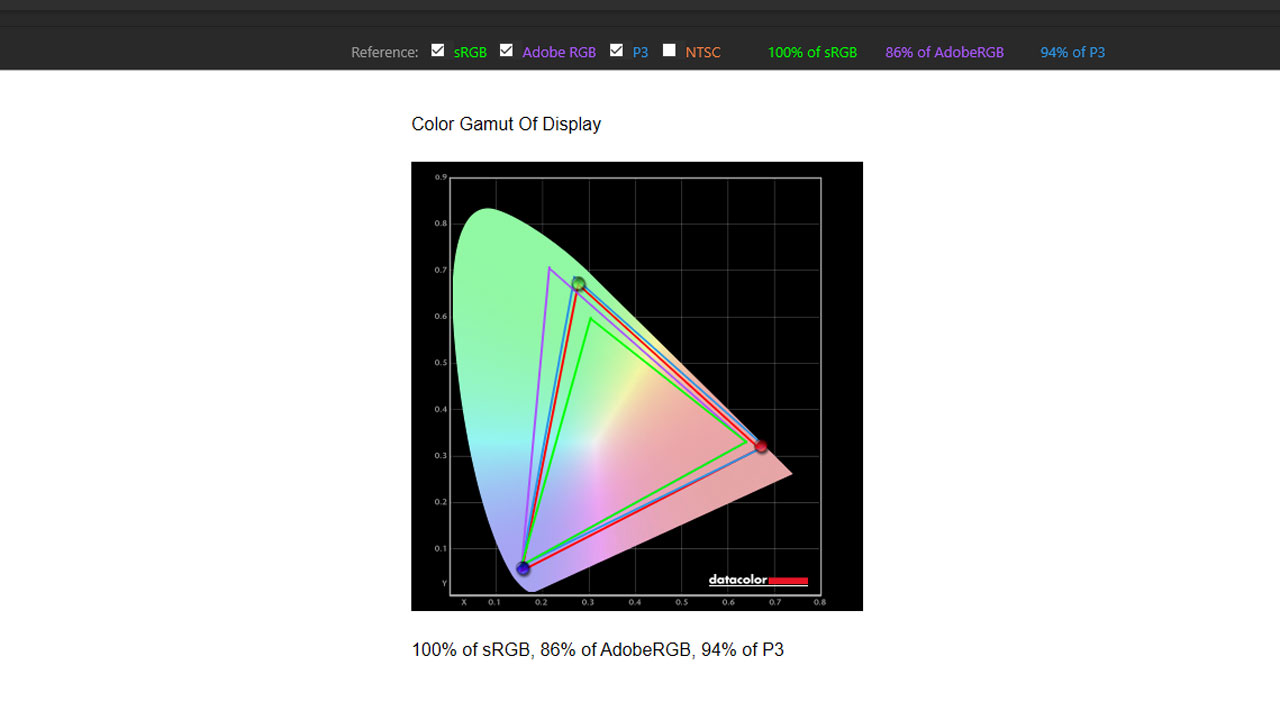
Color coverage is excellent for its price point. We have 100% coverage for sRGB, 86% for AdobeRGB and 94% for DCI-P3. This is no professional monitor but it has the DNA.
Tone Response
Tone response is measured in gamma value (γ). The test aims to check the gamma value and its presets if there are any.
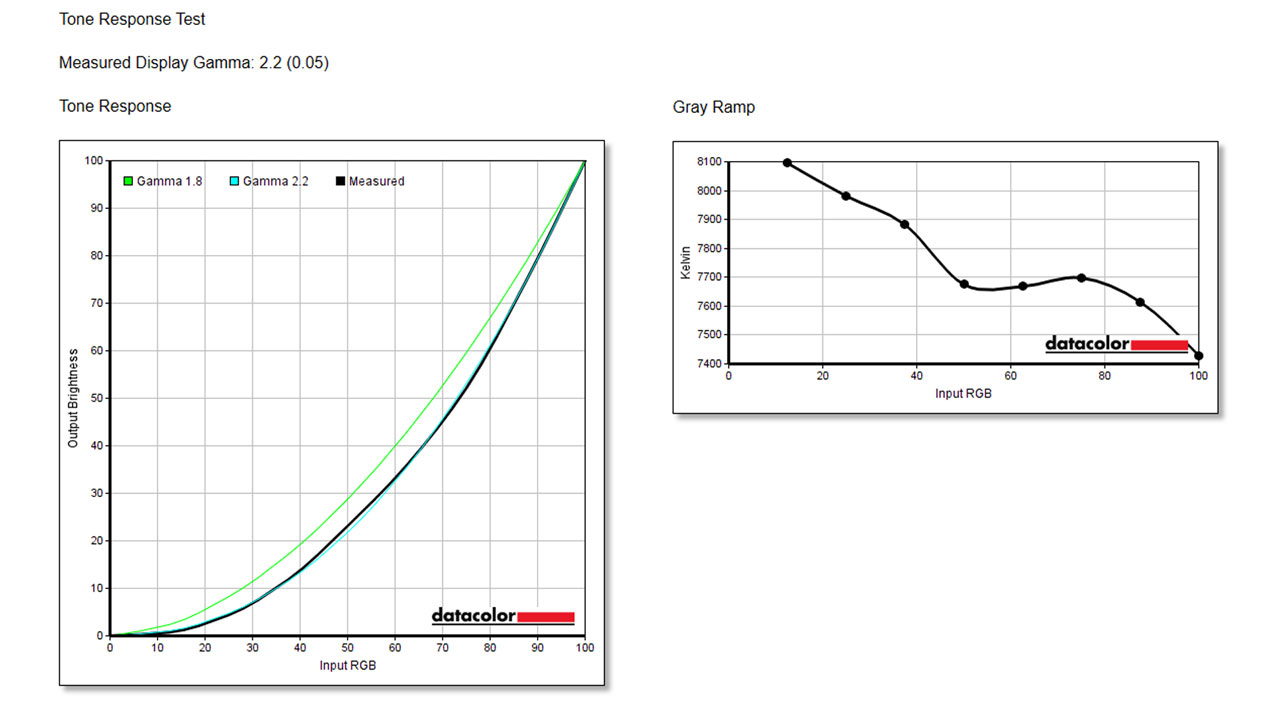
Measured display gamma is 2.2 by default which is appropriate for my taste. Others might find this a bit stale or boring so you may adjust this by increments via the Black Stabilization settings.
Brightness and Contrast
Brightness is measured in candela per square meter (cd/m2) while Contrast is measured in luminance ratio (:). The test aims to check the brightness and contrast levels at different settings.
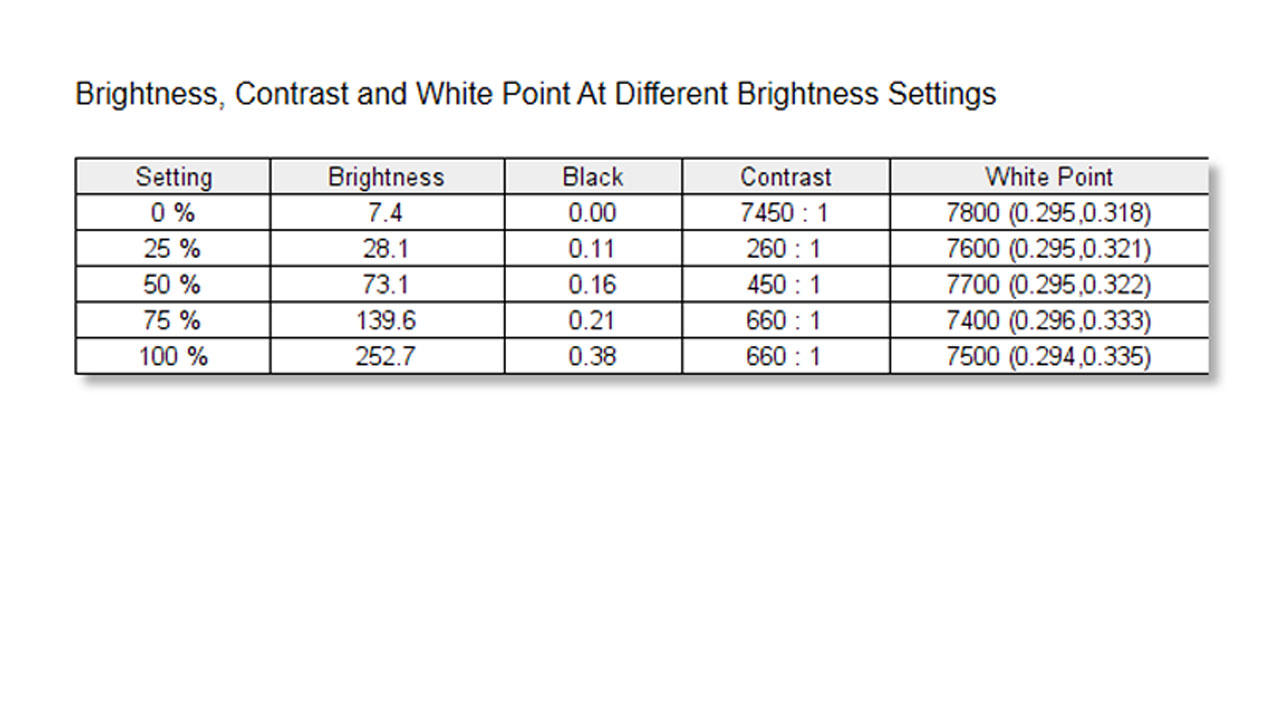
Peak brightness is rated at 252.7 cd/m2 which is a few candelas higher over the specified typical brightness. As for contrast, we got a 660:1 contrast ratio at 100% (for both settings). Middling contrast ratio at our desired gamma level but with an excellent brightness level in tow.
Color and Luminance Uniformity
Color uniformity is measured in Delta-E (∆E) while luminance uniformity is measured in percentage (%). The test aims to check the color and luminance uniformity of the display.
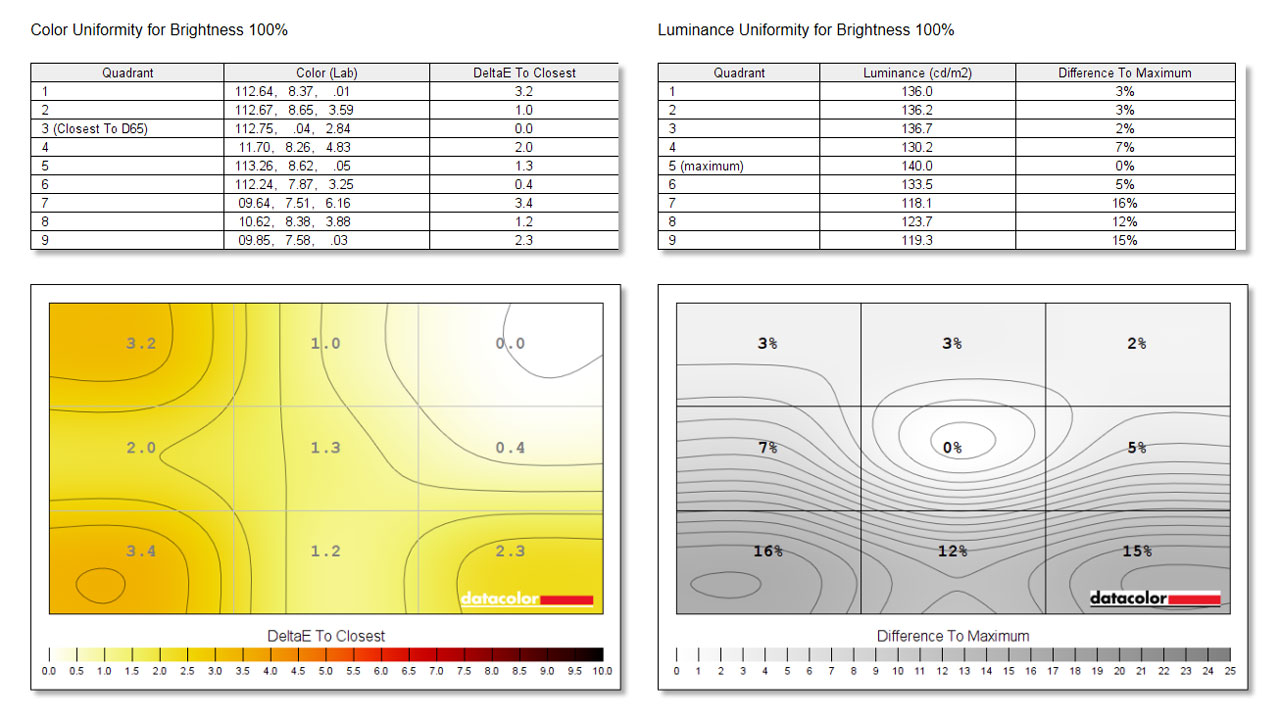
Color uniformity is pretty decent. Luminance uniformity on the other hand is good for the most part except for the lower quadrants.
Color Accuracy
Color accuracy is measured in Delta-E (∆E). The test aims to check the color accuracy of the display.
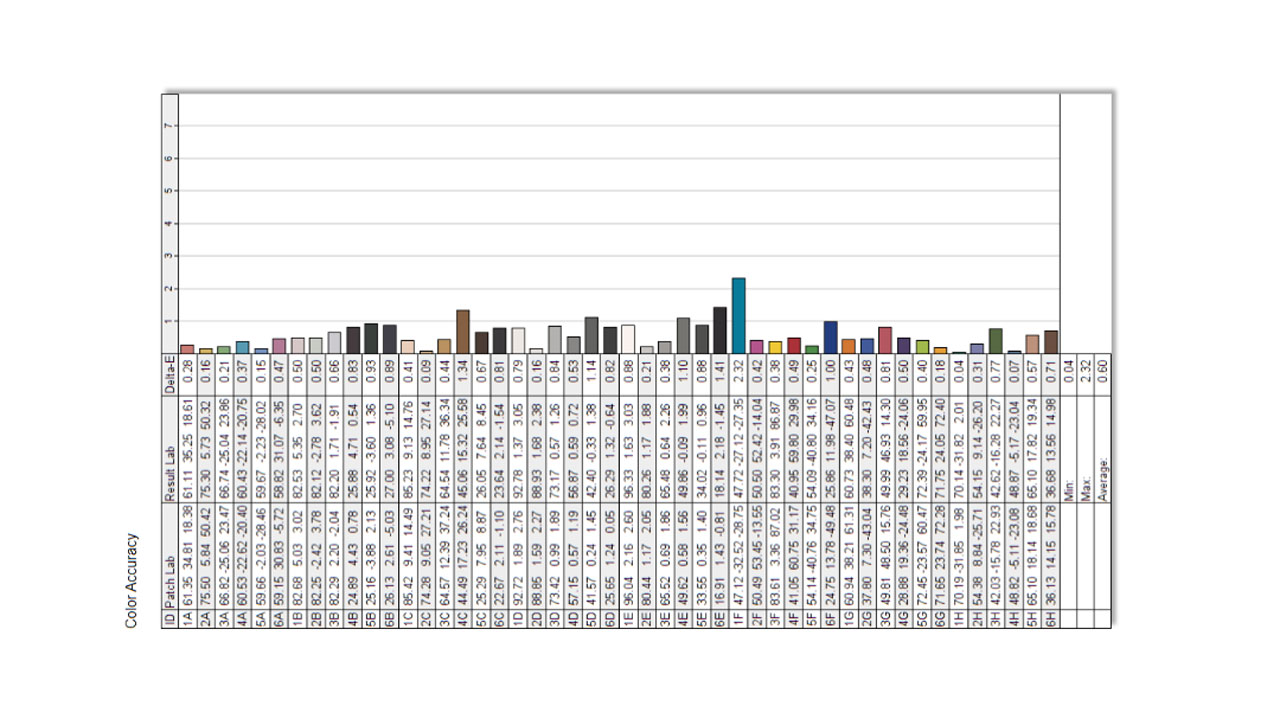
Color accuracy is pretty good with the exception of that one shade of cyan which is yet another persisting issue with ViewSonic panels – least on the recent models tested.
Response Time
Latency is measured in milliseconds (ms). The test aims to check the video signal latency of the display.
| Position | Top | Middle | Bottom |
| Latency, ms (Standard) | 1.85 | 9.13 | 16.47 |
| Latency, ms (Advance) | 2.00 | 9.28 | 16.60 |
| Latency, ms (Fast) | 2.47 | 9.43 | 16.74 |
Average latency is about 9.5 ms – results from the Standard mode combined. Notice that the Advance and Fast modes were slower. I believe ViewSonic had the settings for the Standard and Fast modes reversed.
Motion Clarity
Setting up a pursuit camera allows us to a great extent, perceive the actual motion clarity of the display. Using such method also allows us to check out motion artifacts including ghosting, inverse ghosting and motion blur. This pursuit camera test is a peer-reviewed invention.
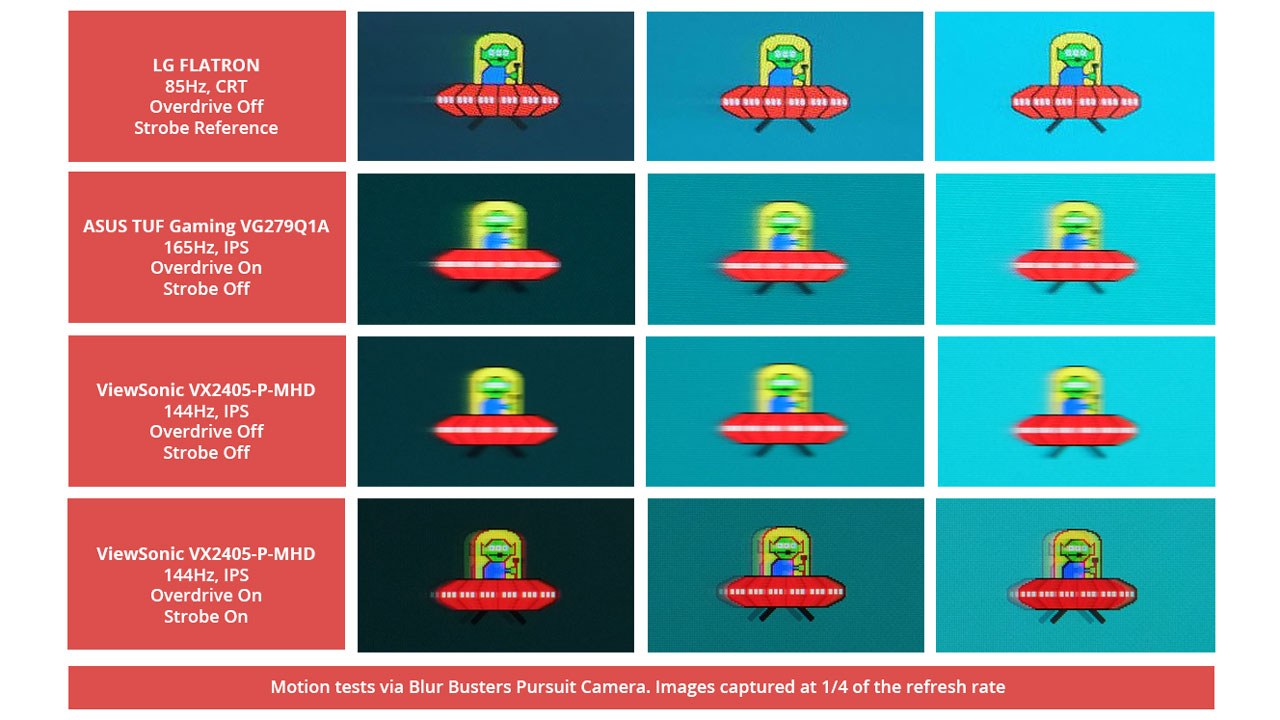
Motion clarity is good enough for an IPS panel with a refresh rate of 144 Hz. It has a usable strobing mode though which is almost unheard of at its price range.
Power Consumption
Power is measured in Watts (W). The test aims to check the power consumption at different brightness levels.
| Brightness Level | 0% | 25% | 50% | 75% | 100% | 120 cd/m2 |
| Power, W | 11.57 | 13.29 | 15.11 | 16.73 | 23.1 | 17.31 |
Power consumption is typical with its size and maximum brightness level. We actually got decent results here when it is calibrated.
Features
The VX2405-P-MHD is a 24-inch IPS panel based gaming display with a 144 Hz refresh rate, adaptive-sync and strobing support. That’s about it for most of its notable features.
It also comes with a 2 W stereo speaker but it sounds anemic – not even worthy of using measurement microphones with. In its defense, I have yet to see a monitor at its price bracket with better output.
Final Thoughts
The ViewSonic VX2405-P-MHD performed extremely well on most of our tests. Though it cannot breach the promised 1 ms GtG response time, it came extremely close.
What else to like are its brightness level, color accuracy, color space coverage and motion clarity. Really few mishaps here and there but I’d like to focus more on the contrast ratio – it really isn’t that great out of the box and will require you to use a lower gamma level to make it a bit more pleasing at the expense of tonal accuracy.
In closing, the ViewSonic VX2405-P-MHD is an inexpensive yet capable IPS based display panel that you could also use perfectly well outside of play.

ViewSonic VX2405-P-MHD Gaming Monitor
Summary
The ViewSonic VX2405-P-MHD is a competitively priced 24-inch gaming display. Its pros totally outweighs its cons so if you’re shopping for an inexpensive monitor or two, this is something you’d want to add to your list.